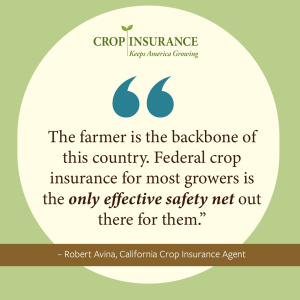As farmers face increasing challenges due to climate change, the safety net provided by crop insurance is their first line of defense. This was one of the messages delivered last week at a panel discussion on mitigating the risks of climate change during the U.S. Department of Agriculture’s (USDA) 2022 Agricultural Outlook Forum.
National Crop Insurance Services President Tom Zacharias was among the stakeholders who spoke on the need to provide predictable risk management tools to America’s farmers.
“Their success depends on a healthy environment. One weather disaster can drive a family farm out of business,” Zacharias explained.
America’s farmers overwhelmingly turn to crop insurance to manage their risks. In 2021, crop insurance insured more than 460 million acres, providing $137 billion dollars in protection. Farmers invested more than $5 billion of their own money to protect the crops that supply Americans with food and fiber.
“As rural America confronts climate change, it is critical that crop insurance remain just as dynamic as the farmers it protects. To accomplish this, crop insurance needs to be widely available, affordable, financially viable, and adaptable,” Zacharias said.
Crop insurance not only works to protect farmers when disaster strikes, but it also complements efforts to incentivize the voluntary adoption of climate-smart farming practices. Congress, USDA’s Risk Management Agency (RMA), and crop insurers have worked together to improve the voluntary adoption of farming practices that increase resiliency, improve conservation, and support a healthy environment.
David Zanoni, Senior Underwriter at RMA, discussed several of the improvements RMA has already made to accommodate new farming practices, including the requirement that farmers adhere to approved conservation plans to protect highly erodible land and wetlands as well as the use of Good Farming Practices, such as cover crops.
Zanoni noted that as agriculture continues to innovate, crop insurance will, too. “It will be a constant evolution of the product line to deal with the challenges of the day,” he said.
Lance Griff, a third-generation farmer from Twin Falls, Idaho, provided a grower perspective, sharing with the audience how he transitioned to utilizing no-till and cover crops in 2013.
“I wanted to leave healthier soil for my kids if they want to farm,” Griff said. “I also wanted our soil to have more resiliency, to endure weather challenges.”
Crop insurance has earned the trust of farmers like Griff, and it is an important part of their risk management plans.
“Crop insurance is a vital tool we employ to help us plan for the upcoming year and mitigate crop production risks that are inherent to farming. These tools help us to be optimistic and resilient in confronting the challenges that face farmers in the 21st century,” Griff said.
Dr. Julia Borman from Verisk Extreme Event Solutions spoke to the highly unpredictable nature of extreme weather and how probabilistic models can help insurers address the challenge of insufficient historical events. “Unlike events such as fire or theft, which are not highly correlated, weather events such as hurricanes are a low frequency and usually high-cost event, there is a strong correlation, and it’s hard to predict the frequency of claims that are going to happen.”
Weather as a driver of crop failure, as well as long-term climate trends, will continue to be a concern for farmers, insurers, and policymakers, Borman said. “One of the major concerns for the insurance industry is balancing that short-term versus long-term perspective,” she said.
Zacharias concluded his remarks by noting that crop insurance must remain affordable, effective, viable, and adaptable to help America’s farmers secure a more sustainable future.
“Looking forward, we know agriculture has an important role to play in the mission to protect our environment and advance climate-smart policies. And we know that a strong and resilient supply of food and fiber is critical for our economy and for our citizens,” he said.









 “Wheat farmers rely on the certainty of the crop insurance program. In turn, the American people can depend on American farmers who are able to…withstand natural disasters.” – Brent Cheyne, President, National Association of Wheat Growers
“Wheat farmers rely on the certainty of the crop insurance program. In turn, the American people can depend on American farmers who are able to…withstand natural disasters.” – Brent Cheyne, President, National Association of Wheat Growers



